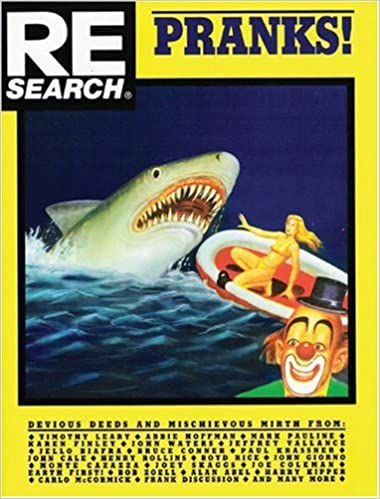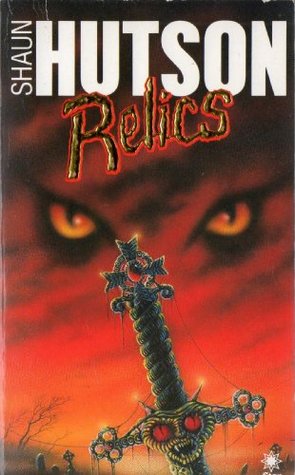Trash Literature (and literature about trash)
“Pranks — Re/Search #11” — The Re/Search Group. Re/Search Publs. 11.95

My first introduction to this group was their previous work on “Incredibly Strange Films” (still available), a real work of genius that was one of the main factors responsible for getting me interested in the work of the marginal film directors and also provided the title for Jonathan Woss‘s series (and the article after this one, too!). Understandably, I was quite looking forward to this book, and although it doesn’t quite come up to the standard of their last work, there are enough gold nuggets to make it a worthwhile read.
The contributors all agree that there is more to the art of pranking than just playing tricks. The more malicious jokes, or those that only confirm the existing way of things are pointless — it takes no guts to execute a prank on a sub-ordinate, who has no means of hitting back. The best ones are those with a definite purpose, such as exposing bureaucracy or showing that you haven’t been ground down by society.
However, beyond this, the pranksters split into a wide variety of groups, ranging from Timothy Leary’s LSD japes through to performance artists who specialise in physically abusing themselves and/or the audience. This broad spectrum means that the- articles vary enormously in content and style, and therefore in how interesting they are; while some pontificate endlessly on the nature of pranks, others are less ethereal and give practical examples. I found the latter much more enjoyable — pranks are a down to earth thing and the lack of seriousness with which they viewed life mirrors my view.
Overall, worth borrowing, if not buying.
“Relics” — Shaun Hutson. Star, 2.95

Never read any of his books before, but picked this one up in the news-agents on Farnborough Station, with a sticker on the front saying it was ‘signed by the author‘. It was something of a pleasant surprise — I expected an endless catalogue of atrocities, but although there is plenty of blood, guts, gore and people getting their eyes gouged out, the linking passages are written better than I expected, and the plot, while not totally original, comfortably holds the interest, with the climax being especially breath-taking.
Basically, it’s a ‘monster on the rampage‘ story. An archaeological dig on a building site finds a network of tunnels (by the simple method of falling into them, one of the members being impaled on a spike in a VERY nasty scene), filled with human remains. People start dying, with their intestines arranged beside them to form letters and their eyes removed. After a lot of this, someone works out what the tunnels are for but to say any more would spoil the story.
It has to be said that after a few gratuitous set—pieces, they do seem to become more or less the same – there’s only so many ways you can describe some one being disembowelled. However, it was still an entertaining read, not quite up to the masters of the genre, Herbert and Barker, who are still a long way ahead in most departments, but enjoyable enough.
“Hollywood Lolita” — Marianne Sinclair. Plexus, 7.95

I’d like to start by stressing that I bought this because it has got a large bit about Nastassja Kinski in it. Any statements to the contrary will be referred to my lawyer (when she gets home from school).
The subject of this book is the history of the nymphette in the cinema, from the earliest days of the silent movies, through Elizabeth Taylor (funny, I could never really think of her as being less than about 50 myself) up to the modern era of Jodie Foster and Brooke Shields. My first thought is that it was a little odd that it was written by a woman – I wouldn’t have thought that the subject matter would have been interesting to a female. Her attitude throughout is not consistent; at times, she almost seems to condone fascination with young girls, while at other times she condemns it strongly, the overall impression being that “it’s alright to look, but not to touch” – fair enough, really.
It does not stick strictly to the title either. While most of it certainly is ‘Hollywood’ based, the section of Nastassja Kinski is heavily based on her, er, ‘relationship’ with Roman Polanski, which took place in Europe. He was not Flayour of the Month in Hollywood then (see elsewhere for some idea why!). As for ‘Lolitas’, those of you that have actually read the book by Nabokov, rather than just flicking through it looking for dirty bits, will know that at the start of the book she is 12, and by the end she is 17. So what the hell is Shirley Temple doing in this book? Surely not even the most depraved paedophile could find anything even remotely attractive about her – I want to vomit at the mere sight of her…
No matter. Keeping my own personal opinions out of this review, it is an interesting book for the most part. Plenty of photographs provide a well- written and documented history of this, previously neglected, area of the cinema. Now, where did I put those heart-shaped sunglasses?